Managing Innovation and Continuous Improvement
VerifiedAdded on 2023/06/04
|14
|3301
|331
AI Summary
This study material covers various topics related to managing innovation and continuous improvement, including Management by Objectives, supply chain and service delivery systems, inventory turnover ratio, Gantt chart, PERT, and more. It also includes ideas to improve call centres and a case study on Woolworths Group Limited.
Contribute Materials
Your contribution can guide someone’s learning journey. Share your
documents today.
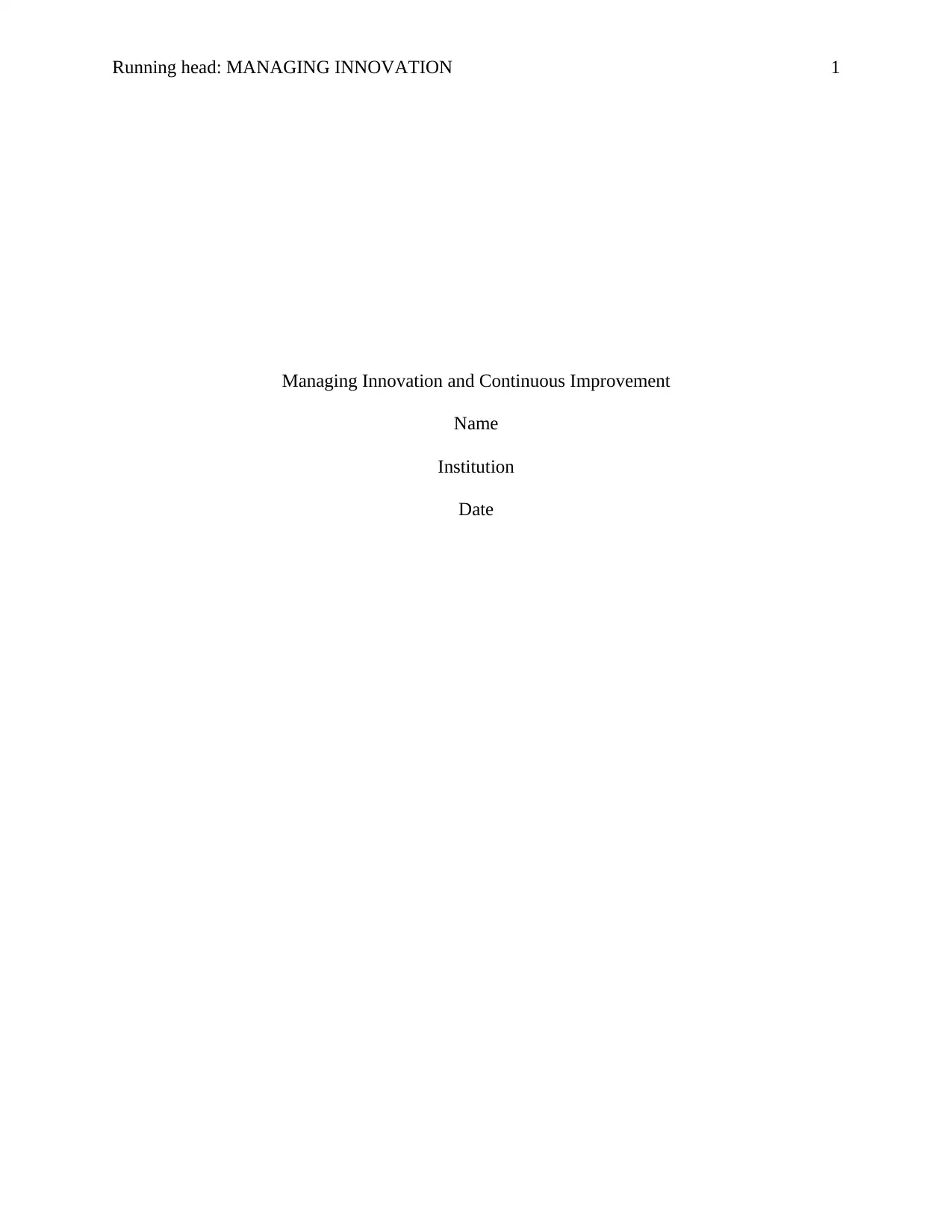
Running head: MANAGING INNOVATION 1
Managing Innovation and Continuous Improvement
Name
Institution
Date
Managing Innovation and Continuous Improvement
Name
Institution
Date
Secure Best Marks with AI Grader
Need help grading? Try our AI Grader for instant feedback on your assignments.
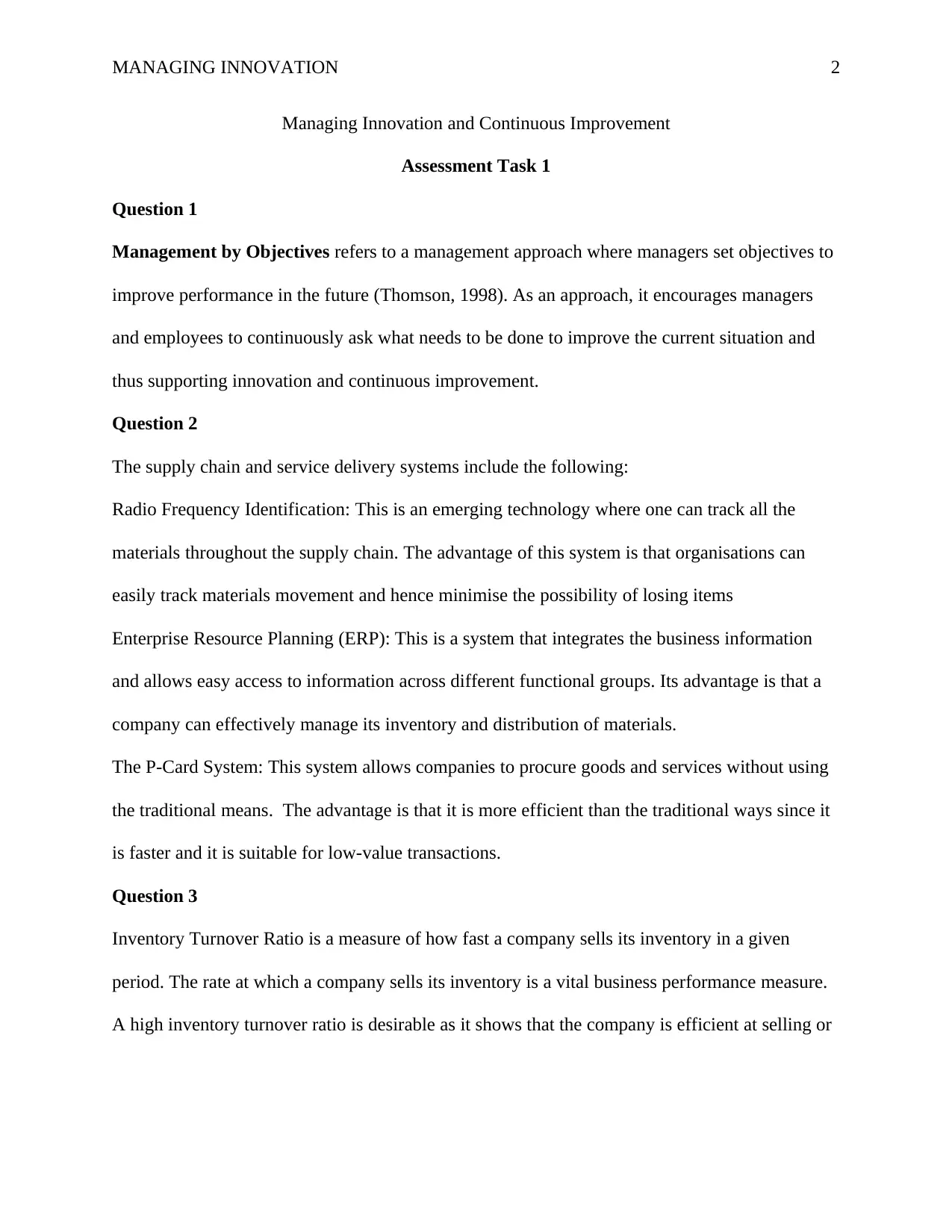
MANAGING INNOVATION 2
Managing Innovation and Continuous Improvement
Assessment Task 1
Question 1
Management by Objectives refers to a management approach where managers set objectives to
improve performance in the future (Thomson, 1998). As an approach, it encourages managers
and employees to continuously ask what needs to be done to improve the current situation and
thus supporting innovation and continuous improvement.
Question 2
The supply chain and service delivery systems include the following:
Radio Frequency Identification: This is an emerging technology where one can track all the
materials throughout the supply chain. The advantage of this system is that organisations can
easily track materials movement and hence minimise the possibility of losing items
Enterprise Resource Planning (ERP): This is a system that integrates the business information
and allows easy access to information across different functional groups. Its advantage is that a
company can effectively manage its inventory and distribution of materials.
The P-Card System: This system allows companies to procure goods and services without using
the traditional means. The advantage is that it is more efficient than the traditional ways since it
is faster and it is suitable for low-value transactions.
Question 3
Inventory Turnover Ratio is a measure of how fast a company sells its inventory in a given
period. The rate at which a company sells its inventory is a vital business performance measure.
A high inventory turnover ratio is desirable as it shows that the company is efficient at selling or
Managing Innovation and Continuous Improvement
Assessment Task 1
Question 1
Management by Objectives refers to a management approach where managers set objectives to
improve performance in the future (Thomson, 1998). As an approach, it encourages managers
and employees to continuously ask what needs to be done to improve the current situation and
thus supporting innovation and continuous improvement.
Question 2
The supply chain and service delivery systems include the following:
Radio Frequency Identification: This is an emerging technology where one can track all the
materials throughout the supply chain. The advantage of this system is that organisations can
easily track materials movement and hence minimise the possibility of losing items
Enterprise Resource Planning (ERP): This is a system that integrates the business information
and allows easy access to information across different functional groups. Its advantage is that a
company can effectively manage its inventory and distribution of materials.
The P-Card System: This system allows companies to procure goods and services without using
the traditional means. The advantage is that it is more efficient than the traditional ways since it
is faster and it is suitable for low-value transactions.
Question 3
Inventory Turnover Ratio is a measure of how fast a company sells its inventory in a given
period. The rate at which a company sells its inventory is a vital business performance measure.
A high inventory turnover ratio is desirable as it shows that the company is efficient at selling or
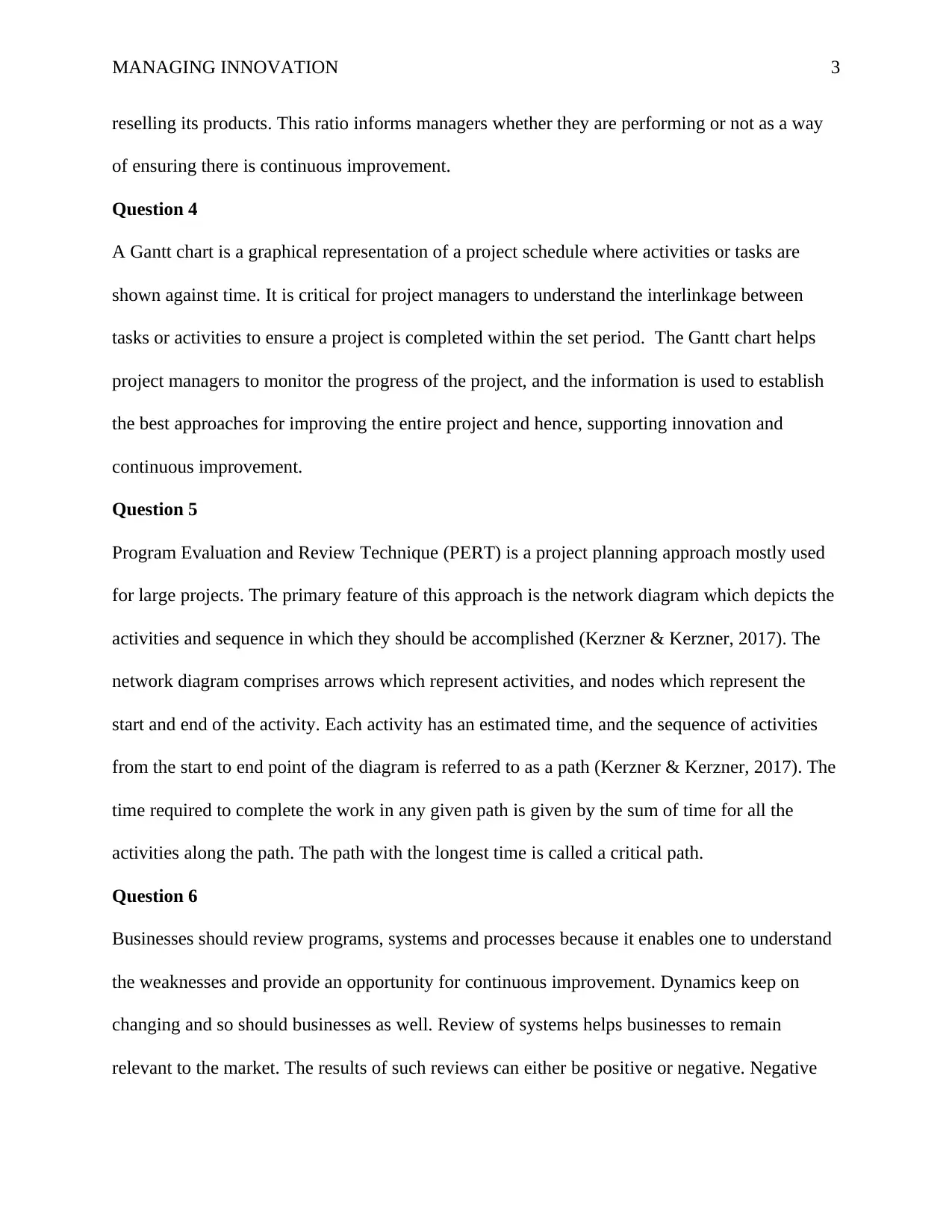
MANAGING INNOVATION 3
reselling its products. This ratio informs managers whether they are performing or not as a way
of ensuring there is continuous improvement.
Question 4
A Gantt chart is a graphical representation of a project schedule where activities or tasks are
shown against time. It is critical for project managers to understand the interlinkage between
tasks or activities to ensure a project is completed within the set period. The Gantt chart helps
project managers to monitor the progress of the project, and the information is used to establish
the best approaches for improving the entire project and hence, supporting innovation and
continuous improvement.
Question 5
Program Evaluation and Review Technique (PERT) is a project planning approach mostly used
for large projects. The primary feature of this approach is the network diagram which depicts the
activities and sequence in which they should be accomplished (Kerzner & Kerzner, 2017). The
network diagram comprises arrows which represent activities, and nodes which represent the
start and end of the activity. Each activity has an estimated time, and the sequence of activities
from the start to end point of the diagram is referred to as a path (Kerzner & Kerzner, 2017). The
time required to complete the work in any given path is given by the sum of time for all the
activities along the path. The path with the longest time is called a critical path.
Question 6
Businesses should review programs, systems and processes because it enables one to understand
the weaknesses and provide an opportunity for continuous improvement. Dynamics keep on
changing and so should businesses as well. Review of systems helps businesses to remain
relevant to the market. The results of such reviews can either be positive or negative. Negative
reselling its products. This ratio informs managers whether they are performing or not as a way
of ensuring there is continuous improvement.
Question 4
A Gantt chart is a graphical representation of a project schedule where activities or tasks are
shown against time. It is critical for project managers to understand the interlinkage between
tasks or activities to ensure a project is completed within the set period. The Gantt chart helps
project managers to monitor the progress of the project, and the information is used to establish
the best approaches for improving the entire project and hence, supporting innovation and
continuous improvement.
Question 5
Program Evaluation and Review Technique (PERT) is a project planning approach mostly used
for large projects. The primary feature of this approach is the network diagram which depicts the
activities and sequence in which they should be accomplished (Kerzner & Kerzner, 2017). The
network diagram comprises arrows which represent activities, and nodes which represent the
start and end of the activity. Each activity has an estimated time, and the sequence of activities
from the start to end point of the diagram is referred to as a path (Kerzner & Kerzner, 2017). The
time required to complete the work in any given path is given by the sum of time for all the
activities along the path. The path with the longest time is called a critical path.
Question 6
Businesses should review programs, systems and processes because it enables one to understand
the weaknesses and provide an opportunity for continuous improvement. Dynamics keep on
changing and so should businesses as well. Review of systems helps businesses to remain
relevant to the market. The results of such reviews can either be positive or negative. Negative
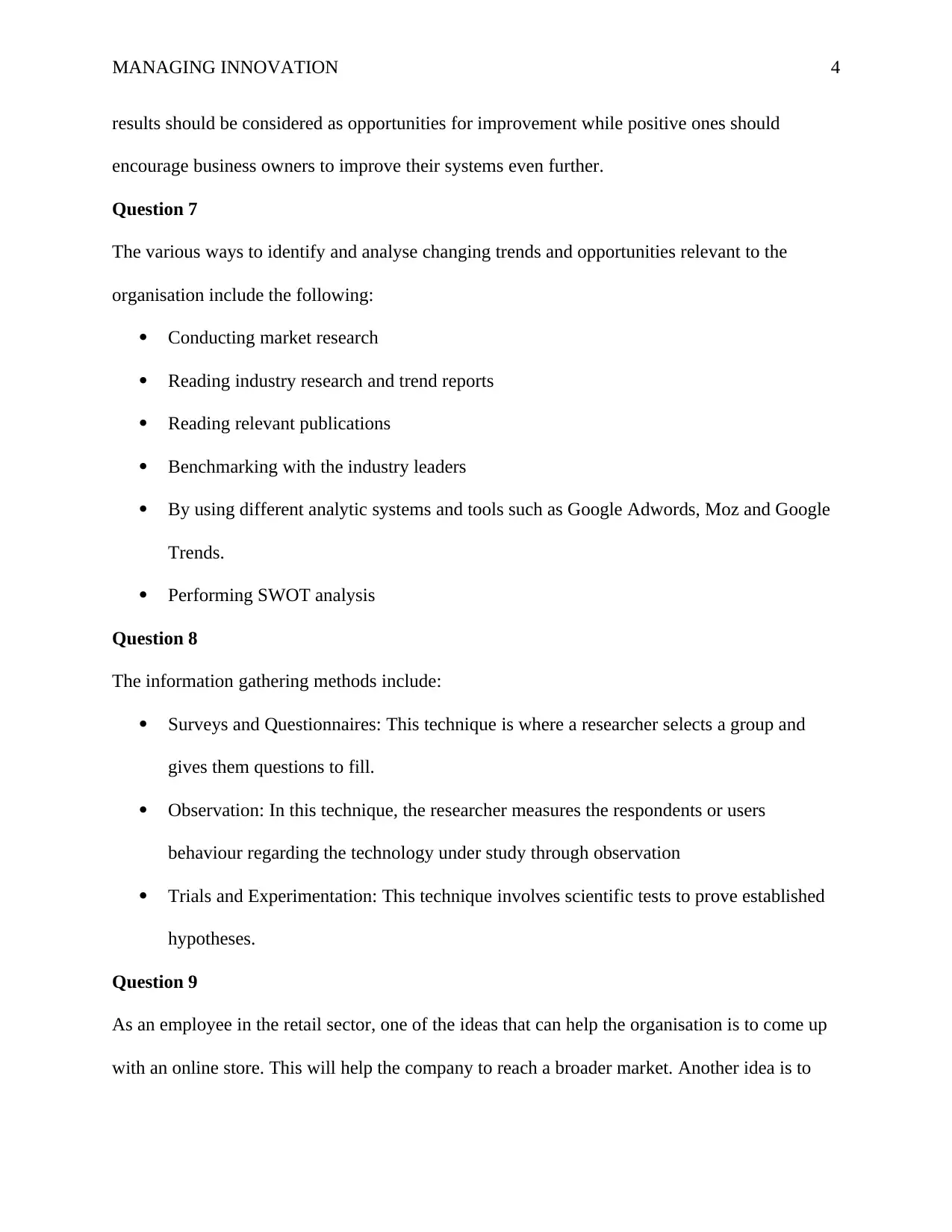
MANAGING INNOVATION 4
results should be considered as opportunities for improvement while positive ones should
encourage business owners to improve their systems even further.
Question 7
The various ways to identify and analyse changing trends and opportunities relevant to the
organisation include the following:
Conducting market research
Reading industry research and trend reports
Reading relevant publications
Benchmarking with the industry leaders
By using different analytic systems and tools such as Google Adwords, Moz and Google
Trends.
Performing SWOT analysis
Question 8
The information gathering methods include:
Surveys and Questionnaires: This technique is where a researcher selects a group and
gives them questions to fill.
Observation: In this technique, the researcher measures the respondents or users
behaviour regarding the technology under study through observation
Trials and Experimentation: This technique involves scientific tests to prove established
hypotheses.
Question 9
As an employee in the retail sector, one of the ideas that can help the organisation is to come up
with an online store. This will help the company to reach a broader market. Another idea is to
results should be considered as opportunities for improvement while positive ones should
encourage business owners to improve their systems even further.
Question 7
The various ways to identify and analyse changing trends and opportunities relevant to the
organisation include the following:
Conducting market research
Reading industry research and trend reports
Reading relevant publications
Benchmarking with the industry leaders
By using different analytic systems and tools such as Google Adwords, Moz and Google
Trends.
Performing SWOT analysis
Question 8
The information gathering methods include:
Surveys and Questionnaires: This technique is where a researcher selects a group and
gives them questions to fill.
Observation: In this technique, the researcher measures the respondents or users
behaviour regarding the technology under study through observation
Trials and Experimentation: This technique involves scientific tests to prove established
hypotheses.
Question 9
As an employee in the retail sector, one of the ideas that can help the organisation is to come up
with an online store. This will help the company to reach a broader market. Another idea is to
Secure Best Marks with AI Grader
Need help grading? Try our AI Grader for instant feedback on your assignments.

MANAGING INNOVATION 5
diversify products and services. Other than providing just one product, including other products
will increase the consumer base. The third innovative idea is to create a mobile app which will
reduce queues and improve convenience.
Question 10
Cost-benefit-analysis refers to a project appraisal technique where the costs are compared with
the benefits. The project will be considered viable if the benefits are more than the costs. A
practical example is when a company want to make a choice between outsourcing service or
doing a project in-house. The costs and benefits associated with both approaches will be
analysed, and the best alternative will be the one with higher benefits.
Question 11
Risk management refers to the practice of identifying. Evaluating and prioritising risks and
develop approaches on how to monitor them in order to minimise their occurrences. The steps
for evaluating risk management plan include the following:
Risk identification: in this step, the company identifies the potential risks
Analysis: The company analyses the risk by determining its occurrence and
consequences
Assessment and Evaluation of the Risk: In this step, the company evaluates and
determines the probability of occurrence and the overall impact and make decisions.
Risk Mitigation: In this step, the company develops strategies on how to eliminate the
problem.
Monitoring: This refers to the following up of the issue to see whether it was solved and
to prevent future occurrence.
diversify products and services. Other than providing just one product, including other products
will increase the consumer base. The third innovative idea is to create a mobile app which will
reduce queues and improve convenience.
Question 10
Cost-benefit-analysis refers to a project appraisal technique where the costs are compared with
the benefits. The project will be considered viable if the benefits are more than the costs. A
practical example is when a company want to make a choice between outsourcing service or
doing a project in-house. The costs and benefits associated with both approaches will be
analysed, and the best alternative will be the one with higher benefits.
Question 11
Risk management refers to the practice of identifying. Evaluating and prioritising risks and
develop approaches on how to monitor them in order to minimise their occurrences. The steps
for evaluating risk management plan include the following:
Risk identification: in this step, the company identifies the potential risks
Analysis: The company analyses the risk by determining its occurrence and
consequences
Assessment and Evaluation of the Risk: In this step, the company evaluates and
determines the probability of occurrence and the overall impact and make decisions.
Risk Mitigation: In this step, the company develops strategies on how to eliminate the
problem.
Monitoring: This refers to the following up of the issue to see whether it was solved and
to prevent future occurrence.
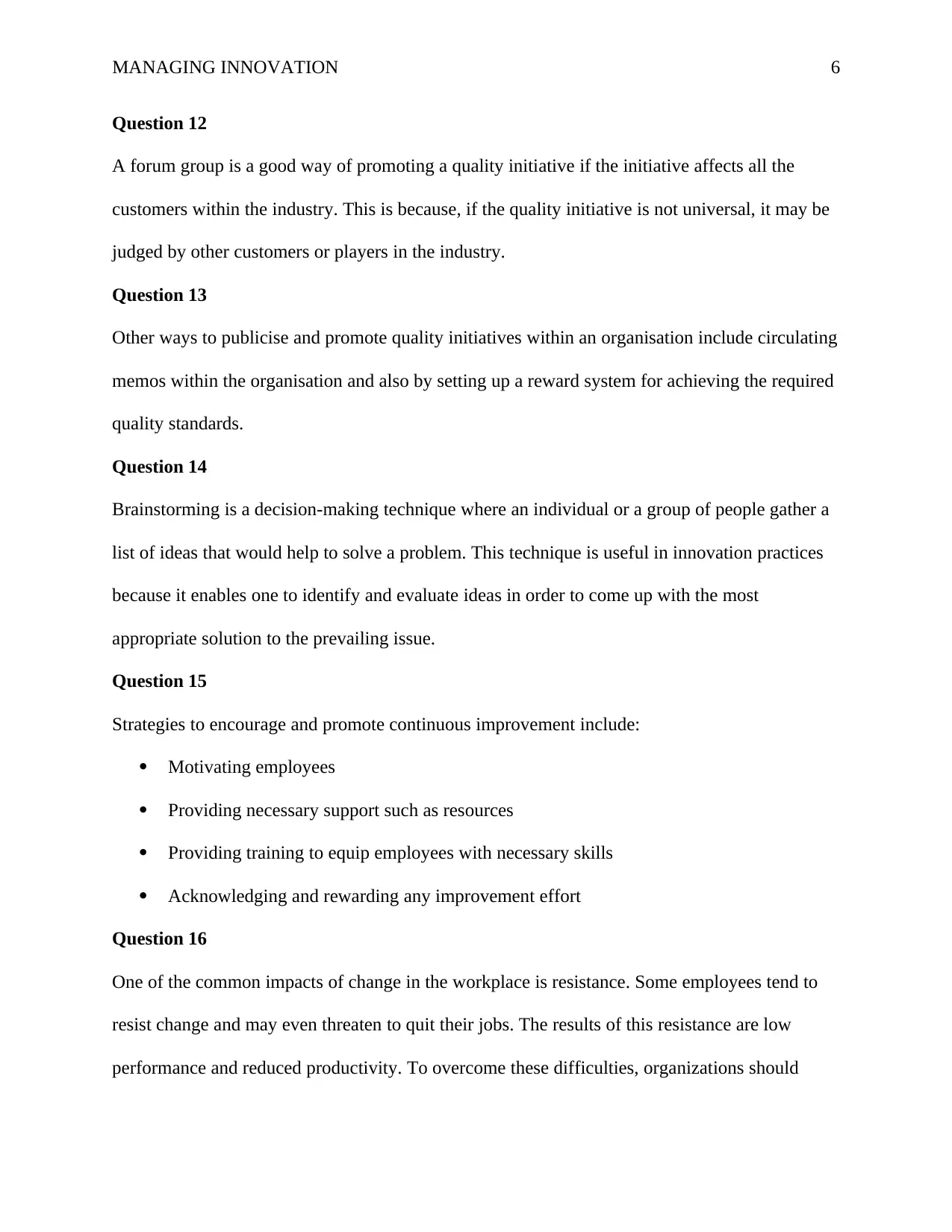
MANAGING INNOVATION 6
Question 12
A forum group is a good way of promoting a quality initiative if the initiative affects all the
customers within the industry. This is because, if the quality initiative is not universal, it may be
judged by other customers or players in the industry.
Question 13
Other ways to publicise and promote quality initiatives within an organisation include circulating
memos within the organisation and also by setting up a reward system for achieving the required
quality standards.
Question 14
Brainstorming is a decision-making technique where an individual or a group of people gather a
list of ideas that would help to solve a problem. This technique is useful in innovation practices
because it enables one to identify and evaluate ideas in order to come up with the most
appropriate solution to the prevailing issue.
Question 15
Strategies to encourage and promote continuous improvement include:
Motivating employees
Providing necessary support such as resources
Providing training to equip employees with necessary skills
Acknowledging and rewarding any improvement effort
Question 16
One of the common impacts of change in the workplace is resistance. Some employees tend to
resist change and may even threaten to quit their jobs. The results of this resistance are low
performance and reduced productivity. To overcome these difficulties, organizations should
Question 12
A forum group is a good way of promoting a quality initiative if the initiative affects all the
customers within the industry. This is because, if the quality initiative is not universal, it may be
judged by other customers or players in the industry.
Question 13
Other ways to publicise and promote quality initiatives within an organisation include circulating
memos within the organisation and also by setting up a reward system for achieving the required
quality standards.
Question 14
Brainstorming is a decision-making technique where an individual or a group of people gather a
list of ideas that would help to solve a problem. This technique is useful in innovation practices
because it enables one to identify and evaluate ideas in order to come up with the most
appropriate solution to the prevailing issue.
Question 15
Strategies to encourage and promote continuous improvement include:
Motivating employees
Providing necessary support such as resources
Providing training to equip employees with necessary skills
Acknowledging and rewarding any improvement effort
Question 16
One of the common impacts of change in the workplace is resistance. Some employees tend to
resist change and may even threaten to quit their jobs. The results of this resistance are low
performance and reduced productivity. To overcome these difficulties, organizations should

MANAGING INNOVATION 7
communicate to the employees about the change and the need for the change. This will, at least,
prepare the employees and prevent possible resistance.
Question 17
The key steps for implementing a change are as follows:
Identification of what needs to be changed
Justification of the change to the stakeholders
Planning for the change
Provision of necessary resources and evaluation
A communication plan
Monitoring and managing resistance and budgeting risks
Celebrating the important milestones achieved
Reviewing the change and planning for continuous improvement
Question 18
The critical information to be included in a project transition plan includes the following:
Project specifications
Definition of the problem
The key performance indicators and objectives
Development credentials
Code documentation
Assets transfer information such as design files, mock-ups
Development credentials
Development procedures
communicate to the employees about the change and the need for the change. This will, at least,
prepare the employees and prevent possible resistance.
Question 17
The key steps for implementing a change are as follows:
Identification of what needs to be changed
Justification of the change to the stakeholders
Planning for the change
Provision of necessary resources and evaluation
A communication plan
Monitoring and managing resistance and budgeting risks
Celebrating the important milestones achieved
Reviewing the change and planning for continuous improvement
Question 18
The critical information to be included in a project transition plan includes the following:
Project specifications
Definition of the problem
The key performance indicators and objectives
Development credentials
Code documentation
Assets transfer information such as design files, mock-ups
Development credentials
Development procedures
Paraphrase This Document
Need a fresh take? Get an instant paraphrase of this document with our AI Paraphraser
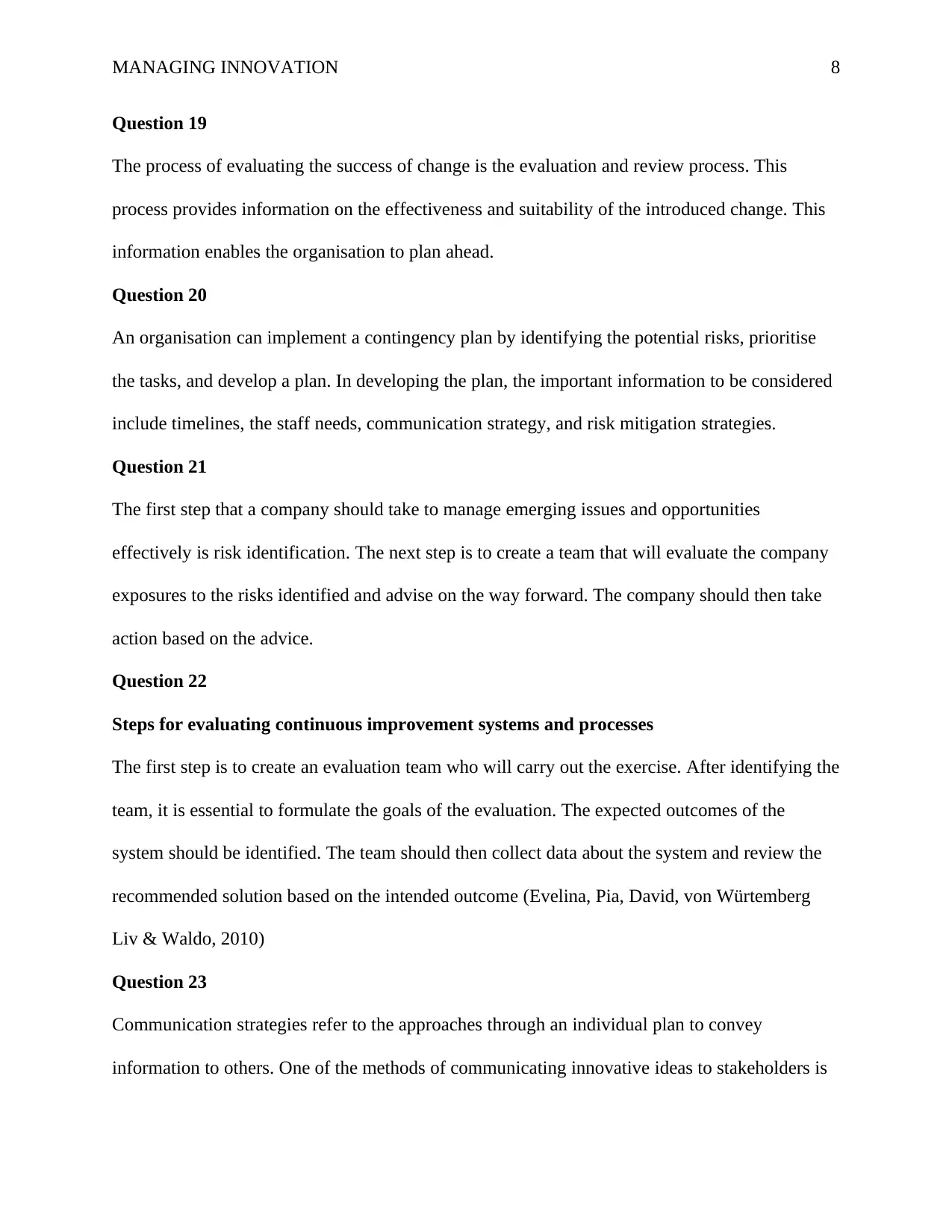
MANAGING INNOVATION 8
Question 19
The process of evaluating the success of change is the evaluation and review process. This
process provides information on the effectiveness and suitability of the introduced change. This
information enables the organisation to plan ahead.
Question 20
An organisation can implement a contingency plan by identifying the potential risks, prioritise
the tasks, and develop a plan. In developing the plan, the important information to be considered
include timelines, the staff needs, communication strategy, and risk mitigation strategies.
Question 21
The first step that a company should take to manage emerging issues and opportunities
effectively is risk identification. The next step is to create a team that will evaluate the company
exposures to the risks identified and advise on the way forward. The company should then take
action based on the advice.
Question 22
Steps for evaluating continuous improvement systems and processes
The first step is to create an evaluation team who will carry out the exercise. After identifying the
team, it is essential to formulate the goals of the evaluation. The expected outcomes of the
system should be identified. The team should then collect data about the system and review the
recommended solution based on the intended outcome (Evelina, Pia, David, von Würtemberg
Liv & Waldo, 2010)
Question 23
Communication strategies refer to the approaches through an individual plan to convey
information to others. One of the methods of communicating innovative ideas to stakeholders is
Question 19
The process of evaluating the success of change is the evaluation and review process. This
process provides information on the effectiveness and suitability of the introduced change. This
information enables the organisation to plan ahead.
Question 20
An organisation can implement a contingency plan by identifying the potential risks, prioritise
the tasks, and develop a plan. In developing the plan, the important information to be considered
include timelines, the staff needs, communication strategy, and risk mitigation strategies.
Question 21
The first step that a company should take to manage emerging issues and opportunities
effectively is risk identification. The next step is to create a team that will evaluate the company
exposures to the risks identified and advise on the way forward. The company should then take
action based on the advice.
Question 22
Steps for evaluating continuous improvement systems and processes
The first step is to create an evaluation team who will carry out the exercise. After identifying the
team, it is essential to formulate the goals of the evaluation. The expected outcomes of the
system should be identified. The team should then collect data about the system and review the
recommended solution based on the intended outcome (Evelina, Pia, David, von Würtemberg
Liv & Waldo, 2010)
Question 23
Communication strategies refer to the approaches through an individual plan to convey
information to others. One of the methods of communicating innovative ideas to stakeholders is
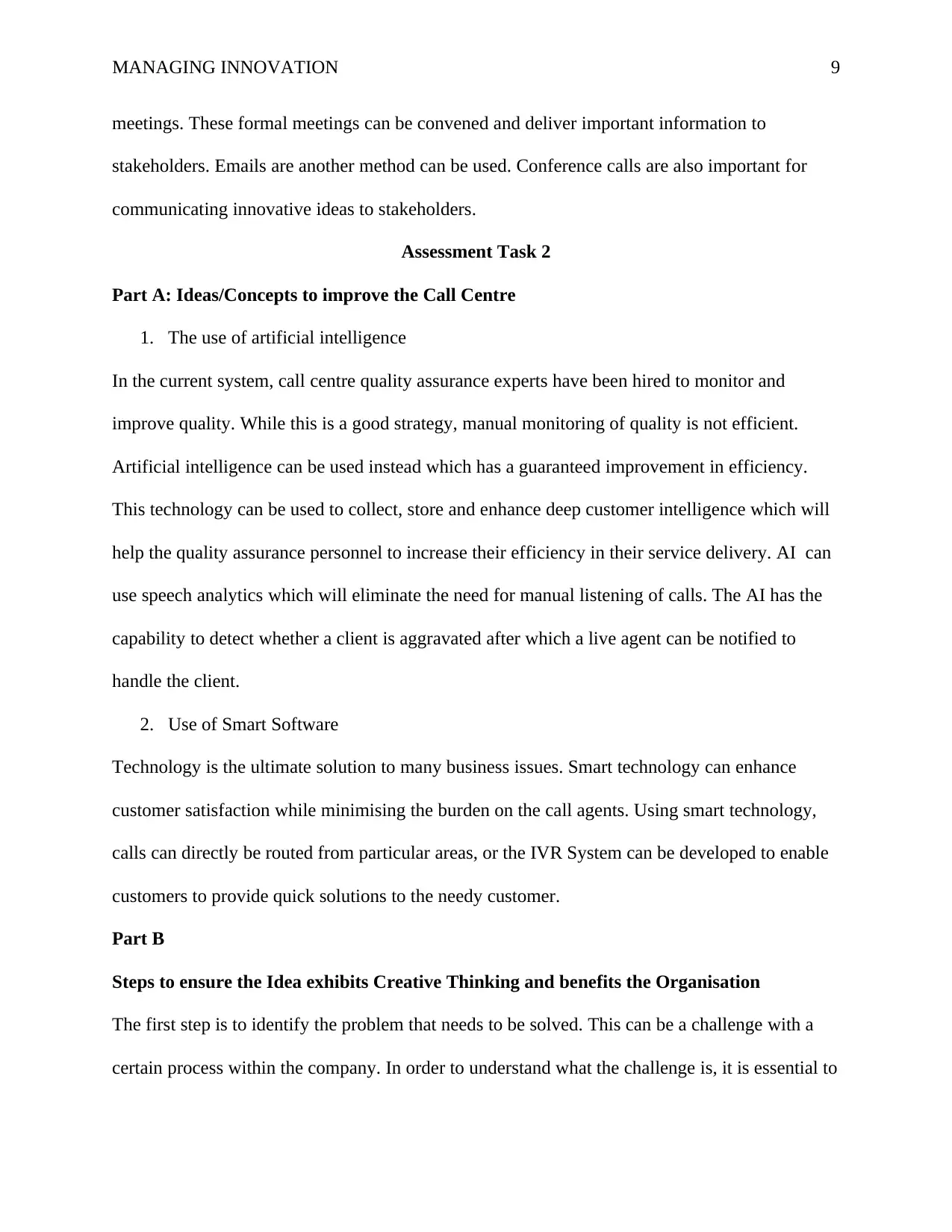
MANAGING INNOVATION 9
meetings. These formal meetings can be convened and deliver important information to
stakeholders. Emails are another method can be used. Conference calls are also important for
communicating innovative ideas to stakeholders.
Assessment Task 2
Part A: Ideas/Concepts to improve the Call Centre
1. The use of artificial intelligence
In the current system, call centre quality assurance experts have been hired to monitor and
improve quality. While this is a good strategy, manual monitoring of quality is not efficient.
Artificial intelligence can be used instead which has a guaranteed improvement in efficiency.
This technology can be used to collect, store and enhance deep customer intelligence which will
help the quality assurance personnel to increase their efficiency in their service delivery. AI can
use speech analytics which will eliminate the need for manual listening of calls. The AI has the
capability to detect whether a client is aggravated after which a live agent can be notified to
handle the client.
2. Use of Smart Software
Technology is the ultimate solution to many business issues. Smart technology can enhance
customer satisfaction while minimising the burden on the call agents. Using smart technology,
calls can directly be routed from particular areas, or the IVR System can be developed to enable
customers to provide quick solutions to the needy customer.
Part B
Steps to ensure the Idea exhibits Creative Thinking and benefits the Organisation
The first step is to identify the problem that needs to be solved. This can be a challenge with a
certain process within the company. In order to understand what the challenge is, it is essential to
meetings. These formal meetings can be convened and deliver important information to
stakeholders. Emails are another method can be used. Conference calls are also important for
communicating innovative ideas to stakeholders.
Assessment Task 2
Part A: Ideas/Concepts to improve the Call Centre
1. The use of artificial intelligence
In the current system, call centre quality assurance experts have been hired to monitor and
improve quality. While this is a good strategy, manual monitoring of quality is not efficient.
Artificial intelligence can be used instead which has a guaranteed improvement in efficiency.
This technology can be used to collect, store and enhance deep customer intelligence which will
help the quality assurance personnel to increase their efficiency in their service delivery. AI can
use speech analytics which will eliminate the need for manual listening of calls. The AI has the
capability to detect whether a client is aggravated after which a live agent can be notified to
handle the client.
2. Use of Smart Software
Technology is the ultimate solution to many business issues. Smart technology can enhance
customer satisfaction while minimising the burden on the call agents. Using smart technology,
calls can directly be routed from particular areas, or the IVR System can be developed to enable
customers to provide quick solutions to the needy customer.
Part B
Steps to ensure the Idea exhibits Creative Thinking and benefits the Organisation
The first step is to identify the problem that needs to be solved. This can be a challenge with a
certain process within the company. In order to understand what the challenge is, it is essential to
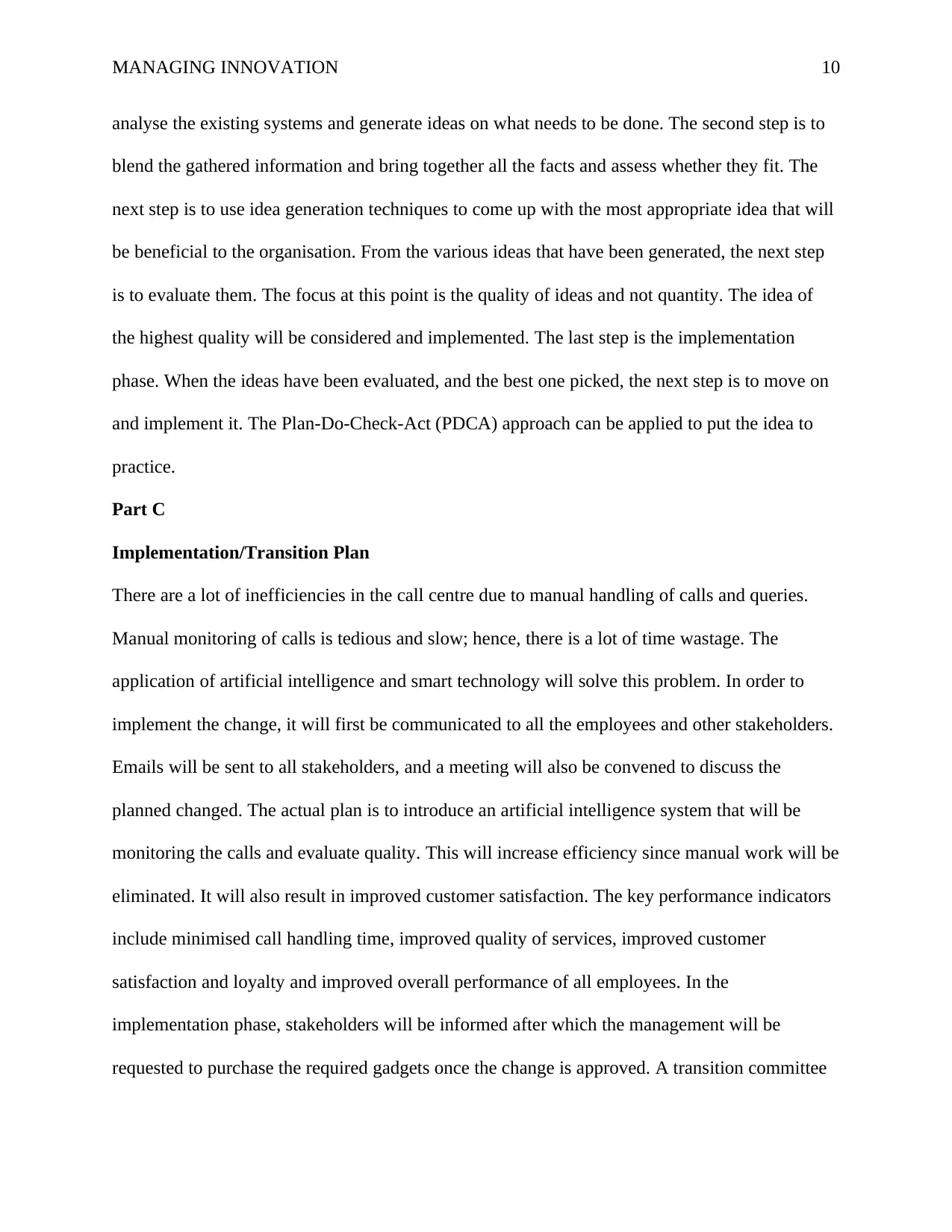
MANAGING INNOVATION 10
analyse the existing systems and generate ideas on what needs to be done. The second step is to
blend the gathered information and bring together all the facts and assess whether they fit. The
next step is to use idea generation techniques to come up with the most appropriate idea that will
be beneficial to the organisation. From the various ideas that have been generated, the next step
is to evaluate them. The focus at this point is the quality of ideas and not quantity. The idea of
the highest quality will be considered and implemented. The last step is the implementation
phase. When the ideas have been evaluated, and the best one picked, the next step is to move on
and implement it. The Plan-Do-Check-Act (PDCA) approach can be applied to put the idea to
practice.
Part C
Implementation/Transition Plan
There are a lot of inefficiencies in the call centre due to manual handling of calls and queries.
Manual monitoring of calls is tedious and slow; hence, there is a lot of time wastage. The
application of artificial intelligence and smart technology will solve this problem. In order to
implement the change, it will first be communicated to all the employees and other stakeholders.
Emails will be sent to all stakeholders, and a meeting will also be convened to discuss the
planned changed. The actual plan is to introduce an artificial intelligence system that will be
monitoring the calls and evaluate quality. This will increase efficiency since manual work will be
eliminated. It will also result in improved customer satisfaction. The key performance indicators
include minimised call handling time, improved quality of services, improved customer
satisfaction and loyalty and improved overall performance of all employees. In the
implementation phase, stakeholders will be informed after which the management will be
requested to purchase the required gadgets once the change is approved. A transition committee
analyse the existing systems and generate ideas on what needs to be done. The second step is to
blend the gathered information and bring together all the facts and assess whether they fit. The
next step is to use idea generation techniques to come up with the most appropriate idea that will
be beneficial to the organisation. From the various ideas that have been generated, the next step
is to evaluate them. The focus at this point is the quality of ideas and not quantity. The idea of
the highest quality will be considered and implemented. The last step is the implementation
phase. When the ideas have been evaluated, and the best one picked, the next step is to move on
and implement it. The Plan-Do-Check-Act (PDCA) approach can be applied to put the idea to
practice.
Part C
Implementation/Transition Plan
There are a lot of inefficiencies in the call centre due to manual handling of calls and queries.
Manual monitoring of calls is tedious and slow; hence, there is a lot of time wastage. The
application of artificial intelligence and smart technology will solve this problem. In order to
implement the change, it will first be communicated to all the employees and other stakeholders.
Emails will be sent to all stakeholders, and a meeting will also be convened to discuss the
planned changed. The actual plan is to introduce an artificial intelligence system that will be
monitoring the calls and evaluate quality. This will increase efficiency since manual work will be
eliminated. It will also result in improved customer satisfaction. The key performance indicators
include minimised call handling time, improved quality of services, improved customer
satisfaction and loyalty and improved overall performance of all employees. In the
implementation phase, stakeholders will be informed after which the management will be
requested to purchase the required gadgets once the change is approved. A transition committee
Secure Best Marks with AI Grader
Need help grading? Try our AI Grader for instant feedback on your assignments.
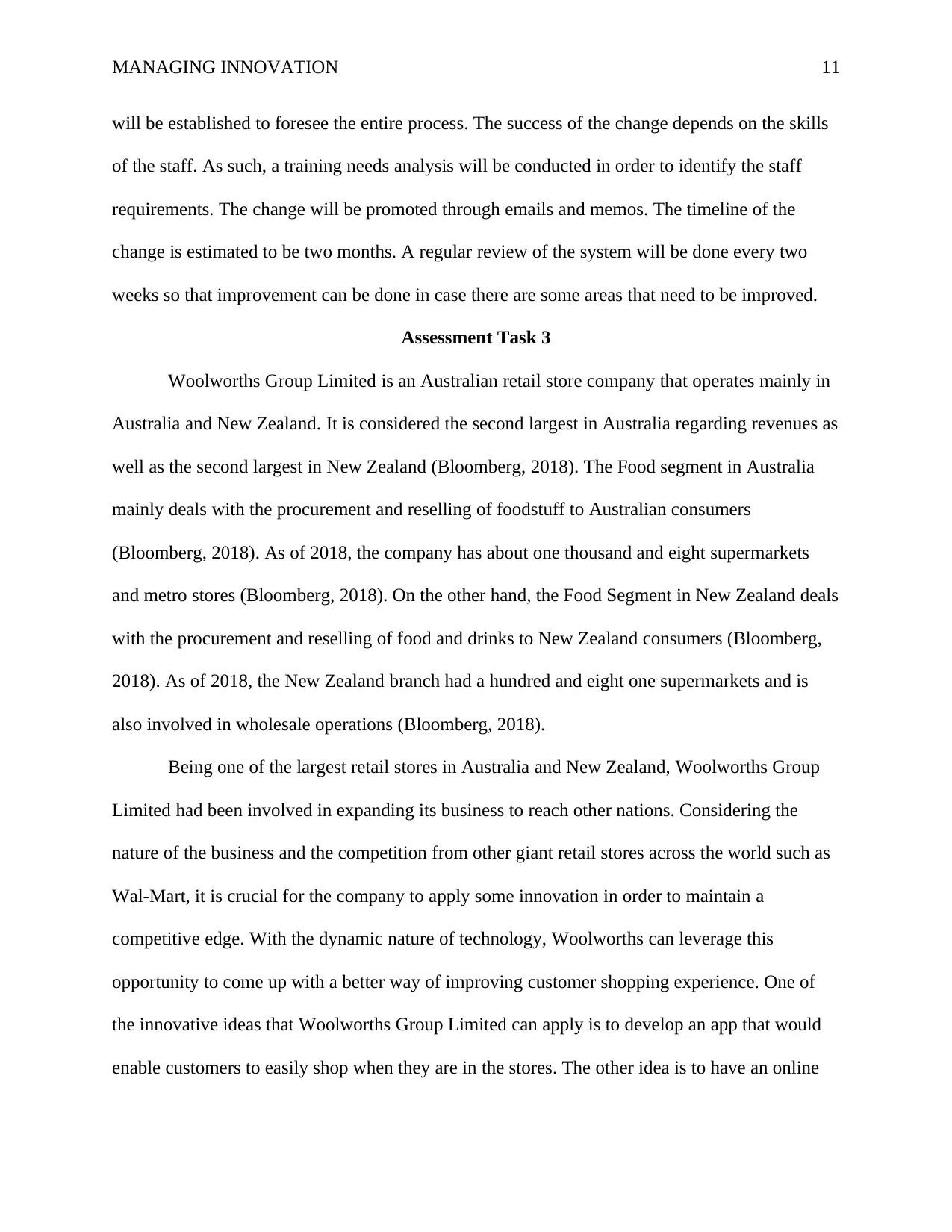
MANAGING INNOVATION 11
will be established to foresee the entire process. The success of the change depends on the skills
of the staff. As such, a training needs analysis will be conducted in order to identify the staff
requirements. The change will be promoted through emails and memos. The timeline of the
change is estimated to be two months. A regular review of the system will be done every two
weeks so that improvement can be done in case there are some areas that need to be improved.
Assessment Task 3
Woolworths Group Limited is an Australian retail store company that operates mainly in
Australia and New Zealand. It is considered the second largest in Australia regarding revenues as
well as the second largest in New Zealand (Bloomberg, 2018). The Food segment in Australia
mainly deals with the procurement and reselling of foodstuff to Australian consumers
(Bloomberg, 2018). As of 2018, the company has about one thousand and eight supermarkets
and metro stores (Bloomberg, 2018). On the other hand, the Food Segment in New Zealand deals
with the procurement and reselling of food and drinks to New Zealand consumers (Bloomberg,
2018). As of 2018, the New Zealand branch had a hundred and eight one supermarkets and is
also involved in wholesale operations (Bloomberg, 2018).
Being one of the largest retail stores in Australia and New Zealand, Woolworths Group
Limited had been involved in expanding its business to reach other nations. Considering the
nature of the business and the competition from other giant retail stores across the world such as
Wal-Mart, it is crucial for the company to apply some innovation in order to maintain a
competitive edge. With the dynamic nature of technology, Woolworths can leverage this
opportunity to come up with a better way of improving customer shopping experience. One of
the innovative ideas that Woolworths Group Limited can apply is to develop an app that would
enable customers to easily shop when they are in the stores. The other idea is to have an online
will be established to foresee the entire process. The success of the change depends on the skills
of the staff. As such, a training needs analysis will be conducted in order to identify the staff
requirements. The change will be promoted through emails and memos. The timeline of the
change is estimated to be two months. A regular review of the system will be done every two
weeks so that improvement can be done in case there are some areas that need to be improved.
Assessment Task 3
Woolworths Group Limited is an Australian retail store company that operates mainly in
Australia and New Zealand. It is considered the second largest in Australia regarding revenues as
well as the second largest in New Zealand (Bloomberg, 2018). The Food segment in Australia
mainly deals with the procurement and reselling of foodstuff to Australian consumers
(Bloomberg, 2018). As of 2018, the company has about one thousand and eight supermarkets
and metro stores (Bloomberg, 2018). On the other hand, the Food Segment in New Zealand deals
with the procurement and reselling of food and drinks to New Zealand consumers (Bloomberg,
2018). As of 2018, the New Zealand branch had a hundred and eight one supermarkets and is
also involved in wholesale operations (Bloomberg, 2018).
Being one of the largest retail stores in Australia and New Zealand, Woolworths Group
Limited had been involved in expanding its business to reach other nations. Considering the
nature of the business and the competition from other giant retail stores across the world such as
Wal-Mart, it is crucial for the company to apply some innovation in order to maintain a
competitive edge. With the dynamic nature of technology, Woolworths can leverage this
opportunity to come up with a better way of improving customer shopping experience. One of
the innovative ideas that Woolworths Group Limited can apply is to develop an app that would
enable customers to easily shop when they are in the stores. The other idea is to have an online
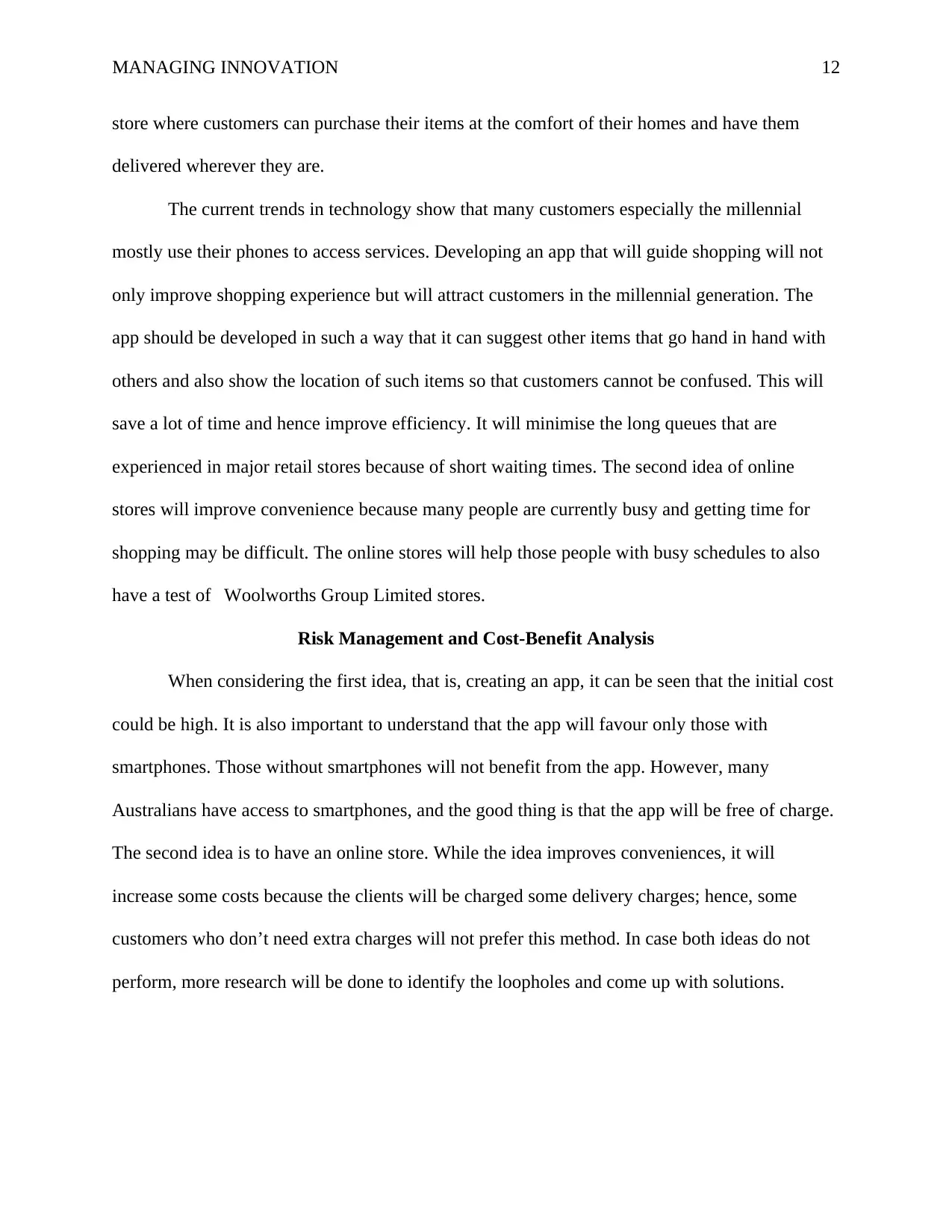
MANAGING INNOVATION 12
store where customers can purchase their items at the comfort of their homes and have them
delivered wherever they are.
The current trends in technology show that many customers especially the millennial
mostly use their phones to access services. Developing an app that will guide shopping will not
only improve shopping experience but will attract customers in the millennial generation. The
app should be developed in such a way that it can suggest other items that go hand in hand with
others and also show the location of such items so that customers cannot be confused. This will
save a lot of time and hence improve efficiency. It will minimise the long queues that are
experienced in major retail stores because of short waiting times. The second idea of online
stores will improve convenience because many people are currently busy and getting time for
shopping may be difficult. The online stores will help those people with busy schedules to also
have a test of Woolworths Group Limited stores.
Risk Management and Cost-Benefit Analysis
When considering the first idea, that is, creating an app, it can be seen that the initial cost
could be high. It is also important to understand that the app will favour only those with
smartphones. Those without smartphones will not benefit from the app. However, many
Australians have access to smartphones, and the good thing is that the app will be free of charge.
The second idea is to have an online store. While the idea improves conveniences, it will
increase some costs because the clients will be charged some delivery charges; hence, some
customers who don’t need extra charges will not prefer this method. In case both ideas do not
perform, more research will be done to identify the loopholes and come up with solutions.
store where customers can purchase their items at the comfort of their homes and have them
delivered wherever they are.
The current trends in technology show that many customers especially the millennial
mostly use their phones to access services. Developing an app that will guide shopping will not
only improve shopping experience but will attract customers in the millennial generation. The
app should be developed in such a way that it can suggest other items that go hand in hand with
others and also show the location of such items so that customers cannot be confused. This will
save a lot of time and hence improve efficiency. It will minimise the long queues that are
experienced in major retail stores because of short waiting times. The second idea of online
stores will improve convenience because many people are currently busy and getting time for
shopping may be difficult. The online stores will help those people with busy schedules to also
have a test of Woolworths Group Limited stores.
Risk Management and Cost-Benefit Analysis
When considering the first idea, that is, creating an app, it can be seen that the initial cost
could be high. It is also important to understand that the app will favour only those with
smartphones. Those without smartphones will not benefit from the app. However, many
Australians have access to smartphones, and the good thing is that the app will be free of charge.
The second idea is to have an online store. While the idea improves conveniences, it will
increase some costs because the clients will be charged some delivery charges; hence, some
customers who don’t need extra charges will not prefer this method. In case both ideas do not
perform, more research will be done to identify the loopholes and come up with solutions.
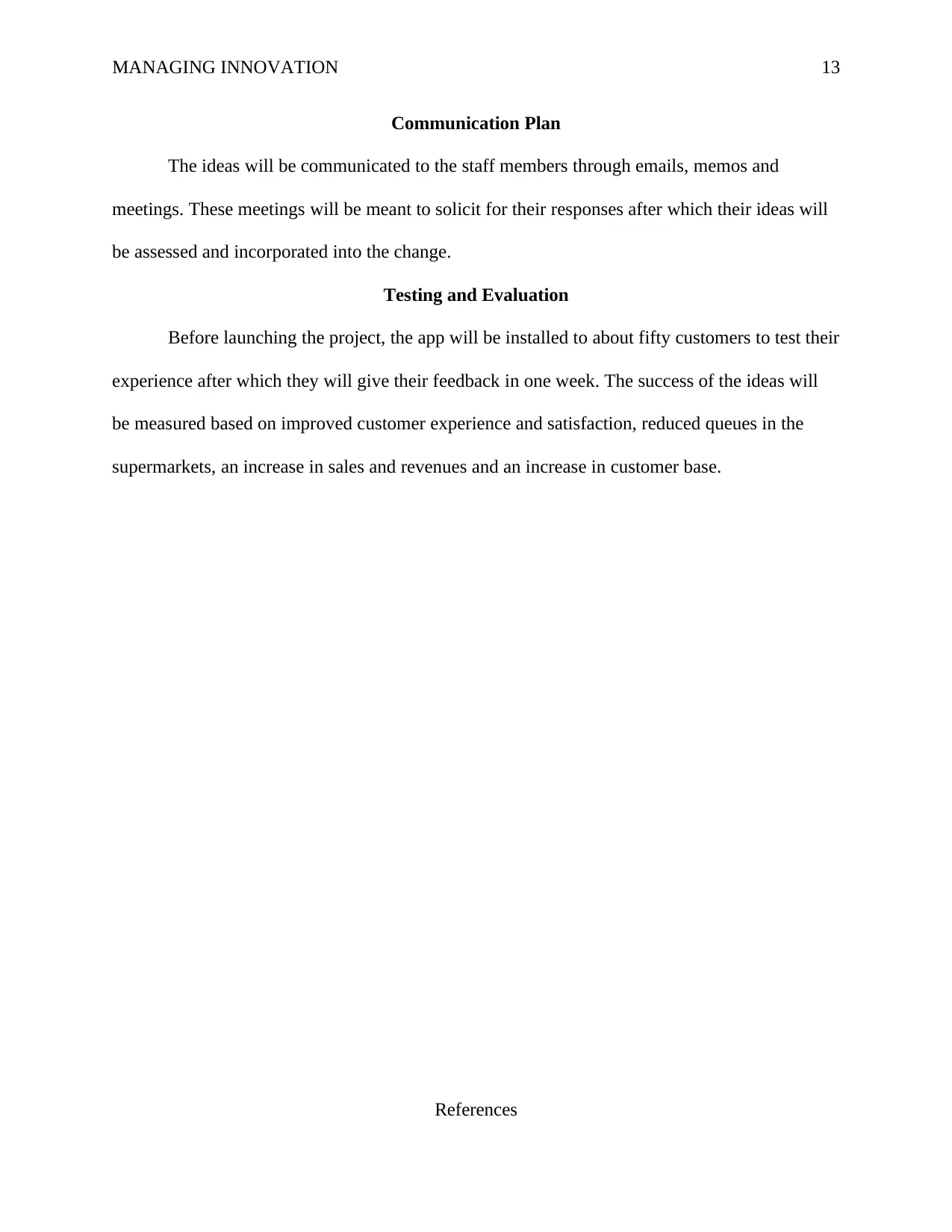
MANAGING INNOVATION 13
Communication Plan
The ideas will be communicated to the staff members through emails, memos and
meetings. These meetings will be meant to solicit for their responses after which their ideas will
be assessed and incorporated into the change.
Testing and Evaluation
Before launching the project, the app will be installed to about fifty customers to test their
experience after which they will give their feedback in one week. The success of the ideas will
be measured based on improved customer experience and satisfaction, reduced queues in the
supermarkets, an increase in sales and revenues and an increase in customer base.
References
Communication Plan
The ideas will be communicated to the staff members through emails, memos and
meetings. These meetings will be meant to solicit for their responses after which their ideas will
be assessed and incorporated into the change.
Testing and Evaluation
Before launching the project, the app will be installed to about fifty customers to test their
experience after which they will give their feedback in one week. The success of the ideas will
be measured based on improved customer experience and satisfaction, reduced queues in the
supermarkets, an increase in sales and revenues and an increase in customer base.
References
Paraphrase This Document
Need a fresh take? Get an instant paraphrase of this document with our AI Paraphraser

MANAGING INNOVATION 14
Bloomberg. (2018). Food and Staples Retailing: Company Overview of Woolworths Group
Limited. Retrieved from
https://www.bloomberg.com/research/stocks/private/snapshot.asp?privcapId=874687
Evelina, E., Pia, G., David, H., von Würtemberg Liv, M., & Waldo, R. F. (2010, November).
Process improvement framework evaluation. In Management Science and Engineering
(ICMSE), 2010 International Conference on (pp. 319-326). IEEE.
Kerzner, H., & Kerzner, H. R. (2017). Project management: a systems approach to planning,
scheduling, and controlling. John Wiley & Sons.
Thomson, T. M. (1998). Management by objectives. The Pfeiffer Library, 20(2), 317.
Bloomberg. (2018). Food and Staples Retailing: Company Overview of Woolworths Group
Limited. Retrieved from
https://www.bloomberg.com/research/stocks/private/snapshot.asp?privcapId=874687
Evelina, E., Pia, G., David, H., von Würtemberg Liv, M., & Waldo, R. F. (2010, November).
Process improvement framework evaluation. In Management Science and Engineering
(ICMSE), 2010 International Conference on (pp. 319-326). IEEE.
Kerzner, H., & Kerzner, H. R. (2017). Project management: a systems approach to planning,
scheduling, and controlling. John Wiley & Sons.
Thomson, T. M. (1998). Management by objectives. The Pfeiffer Library, 20(2), 317.
1 out of 14
![[object Object]](/_next/static/media/star-bottom.7253800d.svg)





